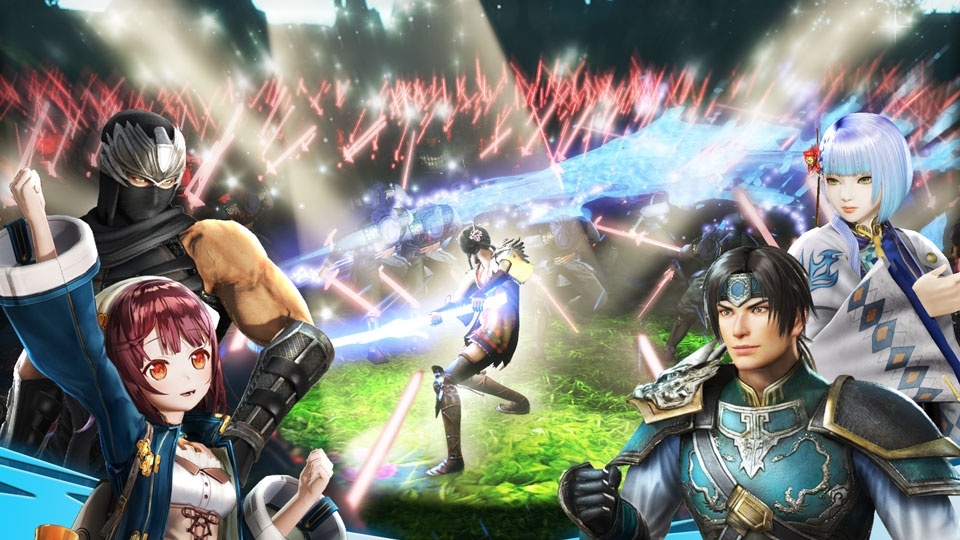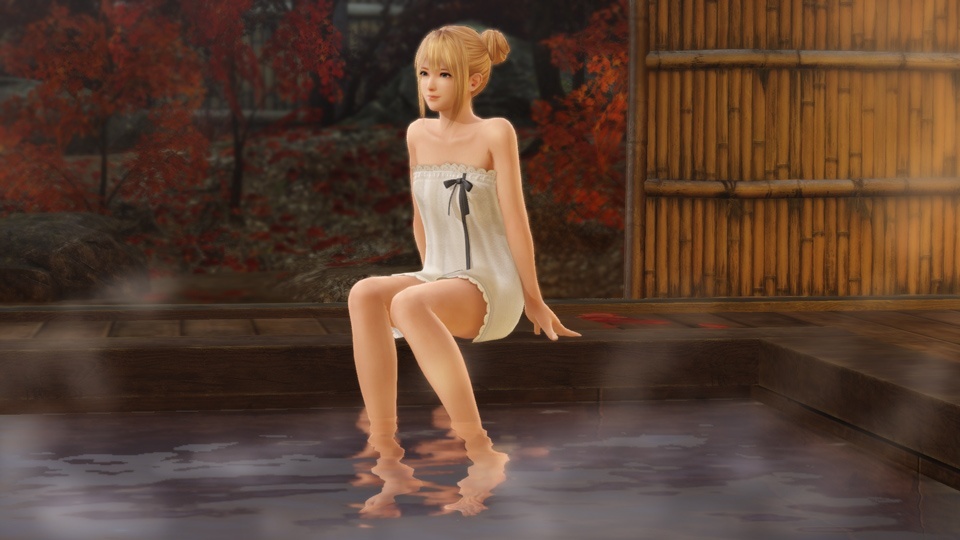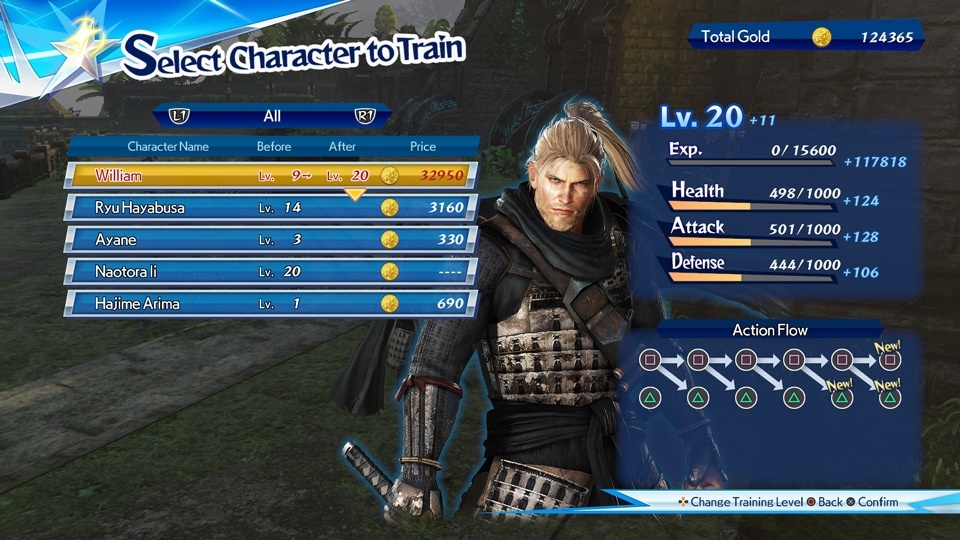Warriors All-Stars (PlayStation 4) Review
By Az Elias  29.08.2017
29.08.2017

Billed as the twentieth anniversary celebration of Koei Tecmo's Omega Force development team, Warriors All-Stars brings together some of the most popular characters from the publisher's wide range of IPs, as they fight and cooperate in order to save an alternate world and return home to their original lands. Does the newest entry in the famed Warriors franchise stand amongst the best of them?
After being summoned to the dying world Warriors All-Stars takes place in, the legendary heroes from across Koei Tecmo's numerous game series are scattered over the lands when the calling process goes wrong. As a result, certain heroes end up fighting for one of three different factions, of which their leaders are all vying for the throne. This three-way battle means the heroes aren't just required to lend their strength to saving this alternate world, but also to ensure their new royal companion is the one to park their furry behind on the highest seat in the land.
Choosing one of the available starting characters to begin the quest with determines which faction and anthropomorphic royal leader the hero fights for, and by taking part in missions around the world map, more allies can be recruited to join the team. With branching paths and decisions to take, multiple endings (up to 15) can be obtained, at which point a new game must be started with data carried over to start again and unlock the others.
Certain allies can only be recruited through certain factions, unless specific battles are completed in order to bring all heroes together when going for the true ending, but depending on which famous faces are or aren't brought onto the team, or which missions are completed, roads will be blocked off. As Story Mode is the only main mode in the game, Warriors All-Stars has been designed with repeated playthroughs in mind. The huge problem is just how exactly this is handled.

Every time an ending is reached, the clear data is saved and you can start a new game to bring over the levels, cards and friendship levels. However, even if starting out with the exact same character or faction as before, all prior missions must be completed and the same allies must be recruited again in order to get back to the previous point you were at before branching off down multiple paths. At even the second time of asking, it is annoying to redo the same levels to recruit the same heroes, and go through the same brief character intro scenes mid-battle to get the team back together again - never mind doing this five times or more just to see the other endings.
Matters are worsened due to the needlessly convoluted way the game lists how to unlock each mission. It is entirely possible to accidentally lock yourself onto a certain path that you've already seen the ending of before simply because it isn't explained properly how you already reached specific missions or endings. There had to have been a better way to handle this, such as with a flowchart, or letting players jump around to specific points in time instead of having to restart the game from scratch and replaying countless missions again.
The story itself is totally light-hearted, and this is echoed through the colourful and joyful art style and interactions between characters. Whereas one of the best games in the franchise, Warriors Orochi 3 Ultimate, is a dark game on numerous counts, Warriors All-Stars is almost in complete contrast to it - and it's a positive change that fits for the type of characters that have been brought over. With younger heroes and ones from vibrant and almost cartoony games, including Marie Rose and Honoka from Dead or Alive, Sophie from Atelier Sophie, Nobunyaga Oda from Samurai Cats, and Rio, who started with the DOA Xtreme series, but pretty much became an IP of her own, the cheerful style suits the crossover game well.

Despite the conflicting designs of certain characters, though, which is all the more obvious in cutscenes with still image portraits, there are plenty of expected warriors that fit into the more traditional franchise style, such as Ryu Hayabusa, Ayane and Kasumi of Dead or Alive and Ninja Gaiden, Oka and Horo from Toukiden, Naotora Ii and Yukimura Sanada from Samurai Warriors, and even Nioh's William Adams, who slots in perfectly and is the only character with an English speaking voice. Expect to see him in a potential Warriors Orochi 4 in the future.
Just a note on the voices: it's the same situation as with all previous Warriors games, where there is only English subtitles, so get used to trying to play and read text at the same time. It's not usually too much of a problem because the combat isn't too demanding, what with this being a hack and slash game and all, but it's still a continued complaint with these titles that would be massively appreciated to have that English voice option to alleviate the issue during gameplay.
The roster rounds out at about 30 heroes in total, which is pretty dismal when compared to something like Orochi 3, which featured a ridiculous 100+ cast. In trying not to over represent a particular series, some popular characters have not made the cut, and there is certainly the argument that many won't know who a lot of these heroes are. Plenty of people would have argued in favour of Momiji and Rachel over Marie Rose and Honoka, but it's understandable why the latter two were included - especially because it makes for a few more interesting dialogues between certain other heroes, such as Kasumi talking more about how Honoka reminds her of a certain someone she knows.
Whilst everyone has their standard array of normal and strong attacks that link together for extended combos, many have unique details that allow them to better represent their original designs from their various IPs. Kasumi will add a few extra teleportation attacks at the end of her strong attacks, while William can perform a quicker attack if correctly timing an activation of Zanshin when his sword flashes. This all goes a little way to ensuring each hero feels like how players have always known them.
In general, actual gameplay is very free flowing. With the lack of horse mounts that are standard in other Warriors games, characters can dash at super speed after running for a few paces. At the same time, they can unleash an attack whilst sprinting, allowing foes to be swatted down as you blaze through hordes of them. Although there is no character switching, with only the party leader being controlled for the full duration of a stage, it is possible to temporarily take the reins of another member with the tap of a directional button to perform an Alliance Strike. Link up all five party members and you can charge and wipe out anything in your way, finishing up with a special move if desired. With the ability to cancel attacks through dodging to put together a new set of moves or press onwards, the pace of battles moves quickly.

The downside comes with the aforementioned repeated character intro scenes upon refighting them on a new game with carried-over data, which disrupts the flow, as well as some grievances when it comes to getting juggled and particular character buffs. Oftentimes, getting caught up in a juggle is a sure-fire way to frustration, as there is not always a way to get out until you land on the floor, unless you have an ability that allows for juggle escapes.
Additionally, fighting Oka and Naotora is particularly maddening, as both can activate a temporary invincibility shield. Whilst Naotora's health can still be depleted, she won't die until delivering a final hit after her shield wears off, but Oka is invulnerable to everything with her buff. The best course of action is to keep a juggle going in Naotora's case, and back off until the shield wears off when fighting Oka. Either way, these two really can be the cause of much aggravation.
Each hero has skills that can be activated in battle to help gain an advantage, which pretty much fall into a category of either attack, support or heal. Placing certain characters into a party can unlock unique Combo Skills that enhance Hero Skills further and provide additional benefits. All of these have cooldown timers that gradually restore during play, or can be hastened through the use of orb pickups or by activating Hero Combos, whereby allies can jump in at the end of a strong attack for a final powerful move. There is no shortage of link-up options with party members, adding a more unified feeling to the characters in the team. A small gripe is the action being paused to view the character activate their Hero Skill when it is used. Skipping this entirely would help keep the battles flowing.

The final move to point out is Musou Fever, an extremely powerful attack that lets the party leader go nuts and unleash havoc on enemies. Enemy numbers increase for spectacle purposes, as you rack up hundreds of KOs, with your party members jumping in front of the screen to cheer you on and boost your power and time limit for the attack. The more KOs, the more members that will offer you support, until everyone jumps in to finish up with one final explosive blow. It's flashy and over the top, but it's an easy way to increase Bravery, especially as one Musou Rush is available at the start of every stage, so it's always recommended to take advantage of it. Every 1000 KOs nets you another Rush Star to perform the Rush again.
Bravery is a special level that always begins at level 1 with every stage entered, and can go up to a max of 10. This affects the strength of the party leader, and can be increased by completing sub missions and defeating opponents. With enemy captains and heroes on the other side being tagged with a Bravery level of their own, it gives an indication of how powerful they are and if you are at the right strength to fight them. You are free to tackle them with a lower Bravery than them, but it won't always result in the best outcome, so the idea is to take over bases, knock up some KOs and complete a few sub missions before taking on the tougher foes of the level.
It's all pretty standard Warriors fare in terms of the mission structure: take over bases and defeat the main bosses. Bases are a bit more unique in that some will enhance the offensive and defensive abilities of other nearby bases, whilst others will drop recovery items or award extra treasure upon mission completion. Although the unique battles that progress the story and unlock allies can't be replayed on the current playthrough, there are countless Field Battles that reward with EXP, cards, gold and materials. These effectively act as grind stages, but can usually be ignored unless desperate for a certain something, or to expand more of the world map to uncover further regions and more battles.

The development of characters has been scaled back when compared to previous Warriors games. This time, instead of equipping weapons, cards replace them in the background, but can be customised a bit by combining multiple cards and enhancing them with materials to add special effects to them. These might include elemental effects, such as fire to burn downed foes, or abilities that increase EXP gained or block attacks from behind. Using the same card over many battles increase its affinity and, in turn, strength.
It's a shame to lose the visible side of character boosting, as the unique weapons from Orochi 3 were always good to see, especially some of the more humorous ones, like giant baseball bats. Nonetheless, the cards work as a replacement, but don't feel quite as rewarding. The difficulty may need turning up, too, as rarely does it seem necessary to actually refine cards and customise them much on the standard difficulty mode.
During mission downtime, the heroes relax at the Sanctuary - a safe haven and place to drink, train and bathe. The atmosphere is a lot more homely than in the camps of previous titles, and this is where you can get to know characters a lot more, seeing how ones from different franchises interact with each other. Requests can be undertaken from allies here, such as being asked to defeat a certain number of foes, in order to receive better cards or increase the bonds between heroes.
The story is extensive enough to keep fans entertained to at least see the main ending through, as well as any character-specific endings that appeal to the individual player, but outside of this, there is, disappointingly, not a lot else here. Whilst other Warriors titles feature multiplayer, online co-op, custom battlefield making, the Gauntlet, and a Free Mode as examples, the sole mode in Warriors All-Stars is the story. There are unlockable wallpapers, character models, spoken lines and such in the gallery, and there is the encyclopaedia to learn more about the characters and the series they all come from, but that is all there is to it.

Once those endings have been seen, there's nothing to come back for. Forget about hooking up with a partner or online friends to create your ultimate dream team of characters and work together, because nothing of the sort exists here. The developer has said they may consider multiplayer as future content, so hopefully that happens, but it seems in general the whole thing is lacking when compared to something like Hyrule Warriors, which was a fantastic celebration of the Zelda IP. By comparison, Warriors All-Stars is a step behind that, and really should have featured more characters and modes if it wanted to truly celebrate Omega Force's long history.
Some localisation errors hurt the translation in parts, and while the frame rate has been brought up in regards to the Japanese version, things are acceptable in this release. There have been reports of the import version running even worse on a PS4 Pro in boost mode, but speaking for the Western version on a standard PS4, whilst it's not as smooth as Orochi 3 Ultimate, it's more than playable. Characters run freely and aren't choppy, and there's no visible screen tearing going on; it's just the lower frame rate that's more noticeable in the background, but doesn't impact the game in any major way. That said, there's no reason it couldn't have been running at the same level as Orochi 3 Ultimate.

Cubed3 Rating
Good
Knowing that Warriors All-Stars is only really going to appeal to Warriors fans, this is definitely a let-down when it comes to being a celebration of some of the best characters and franchises Koei Tecmo has to offer. There just aren't enough characters, the story is the only mode available, and it is pointlessly confusing in its explanation of reaching particular missions and endings. On the other end of the spectrum, though, the gameplay is some of the flashiest and fastest there is, with plenty of variety in move sets across the roster. There will be enough here when it comes to working through the endings for characters that appeal to the individual, but the lacking long term appeal and frustration involved in redoing missions to unlock the same allies and reach previous paths again hurts it.

![]() 6/10
6/10
![]() 0
(0 Votes)
0
(0 Votes)
 Out now
Out now  Out now
Out now  Out now
Out now  Out now
Out now Comments
Comments are currently disabled

 Sign In
Sign In Game Details
Game Details Subscribe to this topic
Subscribe to this topic Features
Features





 Top
Top

